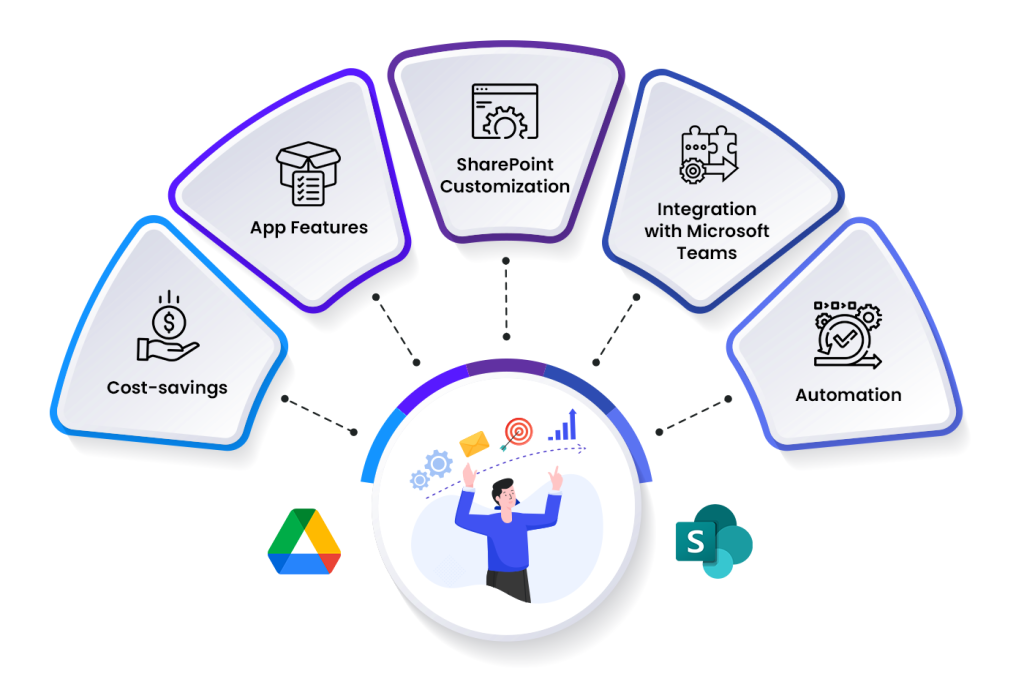Google Drive Migration to SharePoint for Business Growth
Businesses often come to us with the need to migrate Google Drive to SharePoint Online and OneDrive to adopt Microsoft 365 collectively.
Since both cloud suites have a lot in common, why do they make such a large corporate move? What does it mean for businesses to switch to Microsoft 365 from Google Workspace for long-term growth?
This post explores some of the fundamental areas where businesses migrating from Google Drive to OneDrive and SharePoint can achieve long term growth.

1. Cost-savings
There is no denying the fact that Google Workspace and Microsoft 365 have similar business and enterprise pricing. In fact, several business plans from Google workspace are a bit affordable and Microsoft 365. However, there are several indirect ways businesses can lower cloud collaboration expenses more in Microsoft 365.
For example, SMBs can choose the basic Microsoft 365 business plan, integrate a few extra specific Office apps and services they need, and pay for them separately as add-ons. This way, they do not have to commit to a higher-level plan that may include apps and services unnecessary to them.
Businesses can also lower expenses specifically with SharePoint Online by consolidating all the Sites and avoiding the need for siloed administration of each Site.
2. App Features
Google Workspace and Microsoft 365 have a similar set of office and collaboration apps. Although most apps of both cloud suites function in the same way, they have several differences (check our Google Drive vs OneDrive comparison. For example, Microsoft 365 office apps, including Word, Excel, and PowerPoint have more pre-built templates than Google Workspace office apps.
The availability of more pre-built templates across all categories (e.g., budget) may seem trivial but go a long way in improving end user productivity which ultimately reflects in company-wide operational efficiency improvement.
3. SharePoint Customization
Unlike Google Shared Drives, SharePoint Online offers customizability at a granular level. This essentially means that businesses can use the modular design of SharePoint online to their benefit and maximize gains in several key areas, such as workflow management, learning management, onboarding, helpdesk systems, etc.
Since Microsoft allows no-code as well as coded customizations in SharePoint Online, businesses have a lot of customization options which help them meet their specific operations needs. Microsoft has also introduced modern customization options for modern Sites, pages, and libraries.
4. Integration with Microsoft Teams
Microsoft Teams is one of the main reasons why Microsoft 365 is leading the cloud suite space and SharePoint Online integrates seamlessly with the native functions of Teams. Apart from using the basic level of Office apps integration with Teams, businesses can do a lot with the SharePoint Online-Teams combo.
Here are some possibilities:
- Embedding SharePoint Online Pages into Teams
- Setting up default sharing link type
- Working on SharePoint Sites directly from any team in Teams
- Adding teams selectively to certain SharePoint Sites
5. Automation
Unlike Google Workspace, Microsoft 365 is not limited to coded automation options. This is because Power Automate in Microsoft 365 allows business users to automate everyday tasks without deploying any custom code.
With Power Automate’s ability to integrate with a host of Microsoft 365 apps, businesses can efficiently automate simple everyday tasks with the myriad pre-built automation templates and improve efficiency at end-user and team level. Businesses can also create custom automation workflows as per their specific requirements.

Leave A Comment